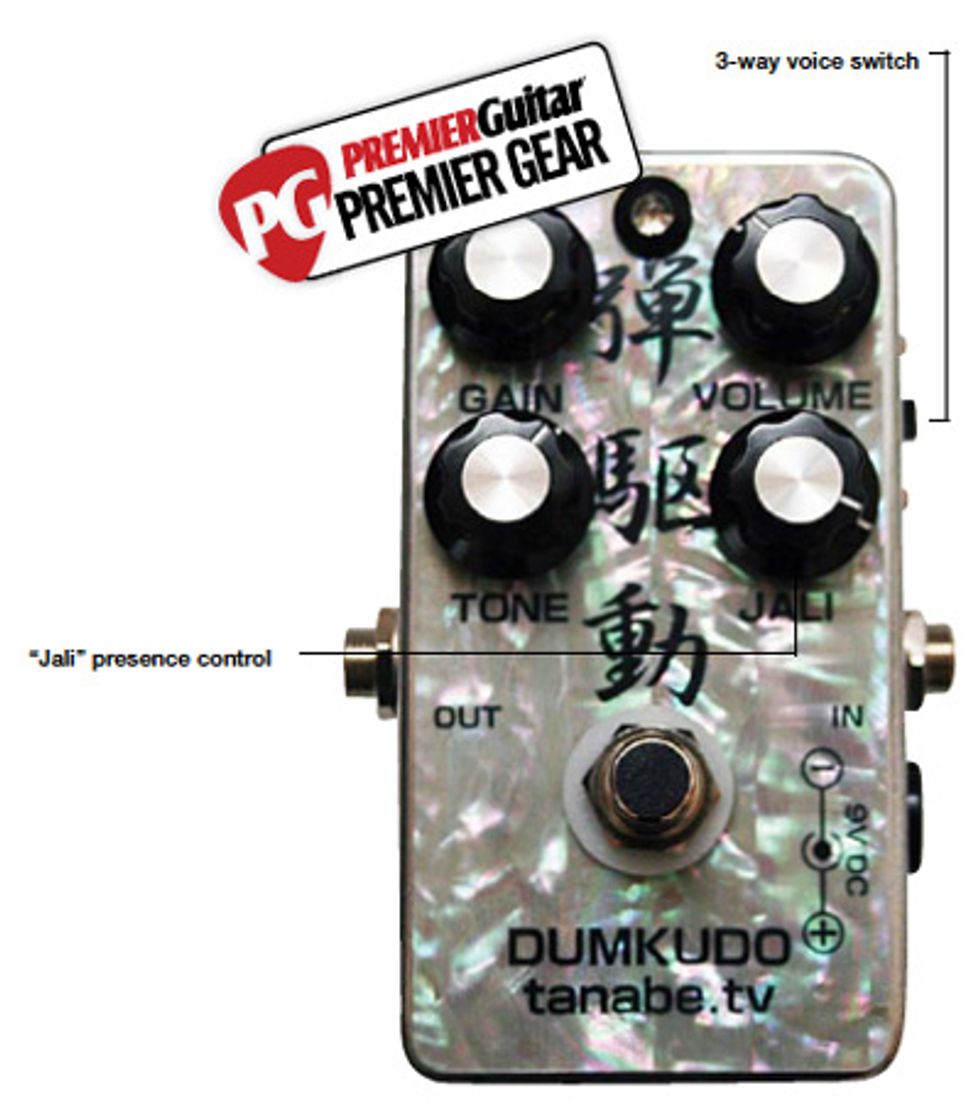 | |
| Download Example 1 Green | |
| Download Example 2 Blue | |
| All clips recorded with a Fano JM6 with P-90s (volume at 8) through a silverface Fender Champ; Pedal settings: Gain at noon, Volume at noon, Tone at 2 o'clock, Jali at 2 o'clock | |
The multi-voiced Dumkudo overdrive is not Toshihiko Tanabe’s first stab at an overdrive. His Zenkudo impressed a lot of blues-rock players with its sweet, controlled overdrive flavors. The Dumkudo shares the Zenkudo’s cultivated voice in some measure. But it also has a lot more sass and swagger. And it’s bound to appeal to everyone from blues and roots-rock players that like a little more horsepower under the hood to jazzers willing to dabble with more impolite tones.
Dressed up for Saturday Night
The Dumkudo is what a good Anglo rocker might call a “flash geezer.” The polished aluminum case and faux-abalone-and-kanji-festooned faceplate stick out amid a pedal array like a sharp-dressed gangster in the corner booth of a crowded club. And when you kick the pedal on, the LED—which switches between red, blue, and green depending on what voice you select— can seem virtually blinding next to your average dull, red pedal light.
The pedal’s four knobs sometimes seem a little cramped on the MXR-sized, 1590 enclosure. But they are easy and intuitive to use once you’ve tinkered with the pedal for a few minutes. The top two knobs are for Gain and Volume. The two sound-shaping controls—Tone and the curiously name Jali knob—are positioned just below.
On the side, a small, unlabeled slider-switch selects one of the pedal’s three voices: a pretty hot “red” mode, a more mellow and rounded “blue” mode (an approximation of the Zenkudo voice), and another hot “green” circuit that gives the pedal its more Dumble-like characteristics.
The pedal’s guts are a fairly cramped affair— no surprise given the four very wide-ranging controls and the switchable voices. I nearly gave myself a headache contemplating Tanabe performing the surgery that must go into constructing the Dumkudo. But for how busy it looks on the inside, it’s clearly built to last. Critical controls like the switchwork and certain connections on the circuit board are sheathed in a rather grotesque looking protective goo that ensures that this pedal remains intact, reliable, and road-ready over the long haul. It’s hard to imagine anyone other than Tanabe working on the Dumkudo if a problem were to arise. But you also get the feeling this pedal could outlive your grandchildren.
Personality and Transparency
The buzz about the Dumkudo is the Dumble-like tones that apparently lurk with in the pedal (we’re guessing the first three letters in its name aren’t there by coincidence, though Tanabe claims this pedal is not intended to be a Dumble emulator). But playing through a range of clean Fender amps, the Dumkudo kicked out a lot of tones that were just as reminiscent of a cranked AC30, a JBL-equipped Showman or Twin, or a bucking 50-watt Marshall.
I explored the Dumkudo’s many voices using a Fender Stratocaster with a Seymour Duncan mini-humbucker in the bridge, a ’70s Ibanez-built Les Paul Standard copy, and a Fender Jaguar running through a blackface Fender Tremolux, a ’68 Vibro Champ and an Ampeg Super Jet.
The first thing that became apparent is that the Dumkudo does not discriminate—humbucker or single-coil, hot or low output pickups, you can find a setting just by manipulating the Gain and Volume knobs that will put some dynamite in your signal without robbing the guitar or amp of too much character.
The mini-humbucker on the Strat and Gibson-styled humbuckers on the Les Paul copy both became exceptionally lively with the Gain and Volume set flat—lending a discernable pick sensitivity that really beckons you to toy with the dynamic potential of pick attack and manipulation of a guitar’s volume and tone knob. Diming the Volume and Gain controls in the Red and Green modes made the humbucker-equipped guitars sound positively explosive without making a Devil’s trade for detail. Such settings didn’t leave much room for slop, however. If, like me, you’re a player who uses a lot of slurring bends, pick sweeps, and jabs for your most expressive playing, this pedal can be a little like the horror of gazing at your complexion in a super-magnifying mirror. If, on the other hand, you have the chops to venture where John McLaughlin dared to fly on his Mahavishnu jams, this might be the pedal of your dreams.
The humbuckers also responded well to the Dumkudo’s very versatile tone manipulation circuit. Getting a little aggressive with the Tone control (which seems to roll off bass as much as it boosts treble) and the Jali control (which functions like a presence knob) had the Strat’s mini-humbucker sweetly squealing in a manner that cried out for an open-G slide workout. At the same settings, the Les Paul copy took on a distinctly Beano-era Bluesbreakers identity when running through the Tremolux and Super Jet.
The Jaguar’s basically snarky, mid-scooped voice also meshed beautifully with the Dumkudo’s higher-gain and treblier settings—particularly in the Green and Red modes. The Blue mode worked quite nicely for adding a little grit to basically clean arpeggios and low-key, Gilmour-y lazy blues leads. In the Green and Red modes, however, careful-but-aggressive use of the Gain knob led the way to some very sweet spots where the Jag, Tremolux, and Super Jet sat right at the brink of feedback—a really fun place to be if you’re inclined to tinker with amp proximity, finger vibrato, and assertive tremolo techniques. And at times, I could get the short-scale Fender quaking and cutting like a smoother incarnation of Jorma Kaukonen slicing eardrums at the Fillmore, circa 1968.
The Dumkudo can just as easily coax you down the path to mellower overdrive without leading you into the realm of generic blooze tones. Again, it walks the fine line between keeping your guitar and amp’s personality intact and adding a touch of skunky roadhouse swagger and attitude. And working with this pedal at lower-gain settings can lure you into an attentive space that keeps you focused on melody and nuance. One note can sound just that interesting.
The Verdict
Toshihiko Tanabe has accomplished an admirable feat in the Dumkudo by taking the well-trodden territory of Dumble-styled, cooking blues-rock tone, and building in the capacity for wider expression, character, and responsiveness. There’s just something a little more alive in the Dumkudo than in your average blues-rock overdrive—an organic property that makes it feel a little more like a part of your amp and guitar. At 310 bones direct from the builder, it’s not cheap. But given that the Dumkudo has the range, build, and character to replace 300 bucks worth of less satisfying ODs you may have sitting around the jam space, you can safely consider it money well spent.
Buy if...
you crave aggressive, dirty blues-rock tones, but need a little more personality and range.
Skip if...
you get everything you need out of your TS9 or Blues Driver.
Rating...
Street $310 - Toshihiko Tanabe - www.tanabe.tv/top/kudou/index-e.html |















![Rig Rundown: Russian Circles’ Mike Sullivan [2025]](https://www.premierguitar.com/media-library/youtube.jpg?id=62303631&width=1245&height=700&quality=70&coordinates=0%2C0%2C0%2C0)









